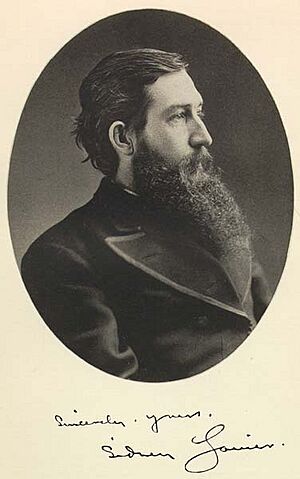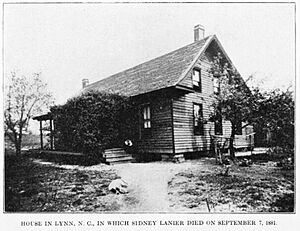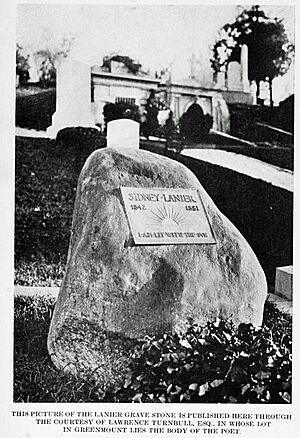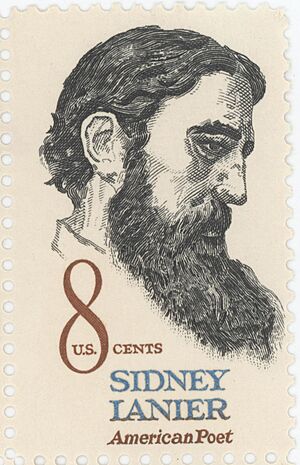Sidney Lanier facts for kids
Quick facts for kids
Sidney Lanier
|
|
|---|---|
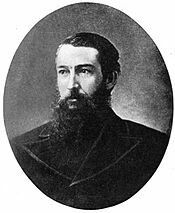 |
|
| Born | Sidney Clopton Lanier February 3, 1842 Macon, Georgia, U.S. |
| Died | September 7, 1881 (aged 39) Lynn, North Carolina, U.S. |
| Resting place | Green Mount Cemetery, Baltimore, Maryland |
| Occupation |
|
| Nationality | American |
| Period | 1867–1881 |
Sidney Clopton Lanier (born February 3, 1842 – died September 7, 1881) was an American musician, poet, and writer. He served in the Confederate States Army during the American Civil War. After the war, he worked many jobs, including teaching, playing music, and practicing law.
Sidney Lanier was a talented flautist and sold his poems to different publications. He later became a professor of literature at Johns Hopkins University in Baltimore. He is known for combining musical rhythm with poetry. Many schools, buildings, and even two lakes are named after him. In the Southern United States, he was called the "poet of the Confederacy." In 1972, a U.S. postage stamp honored him as an "American poet."
Contents
Sidney Lanier's Early Life and War Service
Sidney Clopton Lanier was born on February 3, 1842, in Macon, Georgia. His parents were Robert Sampson Lanier and Mary Jane Anderson. He learned to play the flute at a young age and loved music his whole life.
He attended Oglethorpe University near Milledgeville, Georgia. He was a top student and graduated just before the American Civil War began. The next year, he returned to Oglethorpe as a tutor.
Serving in the Civil War
During the war, Sidney Lanier served in the Confederate army. He worked in the signal corps in Virginia. Later, he and his brother Clifford worked on English ships called blockade runners. These ships tried to get past the Union navy's blockade.
On November 3, 1864, Lanier's ship, the Lucy, was captured. He was sent to a military prison in Point Lookout, Maryland. While there, he became very sick with tuberculosis. This disease was often fatal back then, and he suffered from it for the rest of his life.
Life After the War and Musical Career
After the war, Sidney Lanier taught school for a short time. He then moved to Montgomery, Alabama. There, he worked at the Exchange Hotel as a night clerk. He also performed as a musician at the hotel.
He was the main organist at the First Presbyterian Church in Prattville. While in Alabama, he wrote his only novel, Tiger Lilies (1867). This book was partly based on his own experiences. In 1867, he married Mary Day and moved back to Macon. He started working in his father's law office.
Becoming a Lawyer and a Poet
After passing the Georgia bar exam, Lanier worked as a lawyer for several years. During this time, he wrote poems about the lives of poor farmers in the Southern United States. He traveled a lot, hoping to find a cure for his tuberculosis.
On a trip to Texas, he realized how much he loved playing the flute. He decided to try to become a professional musician. He moved to Baltimore, Maryland, and joined the Peabody Orchestra as a flautist. He quickly became the lead flautist. He was known for a flute piece he wrote called "Black Birds."
To support his wife, Mary, and their three sons, he also wrote poetry for magazines. Some of his most famous poems include "Corn" (1875), "The Symphony" (1875), "The Song of the Chattahoochee" (1877), and "The Marshes of Glynn" (1878). These poems are considered his best works. Many composers have set them to music. "The Marshes of Glynn" describes the large salt marshes in Glynn County, Georgia. The Sidney Lanier Bridge, the longest bridge in Georgia, is named after him.
Later Life and Literary Work
Later in his life, Sidney Lanier became a student and then a professor at Johns Hopkins University in Baltimore. He studied the works of famous English writers like Shakespeare and Chaucer.
He published a series of lectures called The English Novel (1883). He also wrote The Science of English Verse (1880). In this book, he shared his ideas about how music and poetry are connected. He believed that the rhythm of poetry was like musical notation.
Lanier's Unique Writing Style
Sidney Lanier was known for his unique poetry style. He used a special rhythm called "logaoedic dactyls," which was inspired by old Anglo-Saxon poems. He wrote some of his greatest poems, like "The Marshes of Glynn" and "Sunrise," in this style. This rhythm made his poems flow almost like prose, and famous poets like Henry Wadsworth Longfellow admired his work.
Lanier also wrote essays about literature and music. He edited a popular series of four books for boys. These books retold classic stories about knights and chivalry in a way that was easier for young readers to understand:
- The Boy's Froissart (1879): Stories of adventure and battles from medieval times.
- The Boy's King Arthur (1880): Based on the legends of King Arthur and the Knights of the Round Table.
- The Boy's Mabinogion (1881): Old Welsh legends about King Arthur.
- The Boy's Percy (1882): Old ballads about war, adventure, and love.
He also wrote two travel books: Florida: Its Scenery, Climate and History (1875) and Sketches of India (1876). Interestingly, he never actually visited India.
His Final Years
Sidney Lanier passed away from complications of tuberculosis on September 7, 1881. He was only 39 years old. He is buried in Green Mount Cemetery in Baltimore.
Sidney Lanier's Legacy and Honors
Many places and things are named after Sidney Lanier, honoring his contributions as a poet and musician.
Monuments and Memorials
The Sidney Lanier Cottage in Macon, Georgia, where he was born, is a historic landmark. In Augusta, Georgia, there is a monument called the Four Southern Poets Monument. It lists Lanier as one of Georgia's four great poets.
Johns Hopkins University in Baltimore has a large bronze and granite monument dedicated to Lanier. Duke University in Durham, North Carolina, also has a statue of Lanier. It is located on the side of the Duke Chapel.
Works Inspired by Lanier
Lanier's poem "The Marshes of Glynn" inspired a musical piece called a cantata by English composer Andrew Downes. The science-fiction novel Macroscope (1969) by Piers Anthony uses Lanier's life and poetry as part of its story. A Yugoslav rock band, Lutajuća Srca, even recorded a song based on Lanier's "An Evening Poem."
Places Named After Sidney Lanier
Many places across the United States are named in his honor:
Inhabited Places
- Lanier County, Georgia
- Sidney Lanier Avenue in Athens, Georgia
- Lanier Avenue in Fayetteville, Georgia
- Lanier Street in Decatur, Alabama
- Lanier Heights, a neighborhood in Washington, D.C.
Bodies of Water
- Lake Lanier, a large lake northeast of Atlanta, Georgia
- Lake Lanier in Landrum, South Carolina
Schools
- Sidney Lanier High School in Montgomery, Alabama (recently renamed)
- Sidney Lanier School in Gainesville, Florida
- Lanier University, a short-lived university in Atlanta, Georgia
- The Sidney Lanier Building in Brunswick, Georgia
- Lanier Middle School in Sugar Hill, Georgia
- Lanier High School in Sugar Hill, Georgia
- Lanier Elementary School in Gainesville, Georgia
- Sidney Lanier Elementary School in Tulsa, Oklahoma
- Sidney Lanier High School in Austin, Texas (recently renamed)
- Sidney Lanier Expressive Arts Vanguard Elementary School in Dallas, Texas
- Lanier Middle School in Houston, Texas (recently renamed)
- Lanier High School in San Antonio, Texas
- Sidney Lanier Elementary School in Tampa, Florida
- Lanier Technical College in Gainesville, Georgia
- Katherine Johnson Middle School in Fairfax, Virginia (formerly Sidney Lanier Middle School)
- Lanier Elementary school in Blount County, Tennessee
Other Memorials

- Sidney Lanier Cottage, his birthplace in Macon, Georgia
- Sidney Lanier Bridge over the South Brunswick River in Brunswick, Georgia
- Sidney Lanier Monument in Piedmont Park in Atlanta
- Lanier's Oak in Brunswick, Georgia
- The Lanier Library in Tryon, North Carolina
- The World War II Liberty Ship SS Sidney Lanier was named for him.
- A 1972 U.S. postage stamp honored him.
- Sidney Lanier Memorial Scholarship at the University of California, Los Angeles
- Lanier Island in the Mackay River in Glynn County, Georgia.


